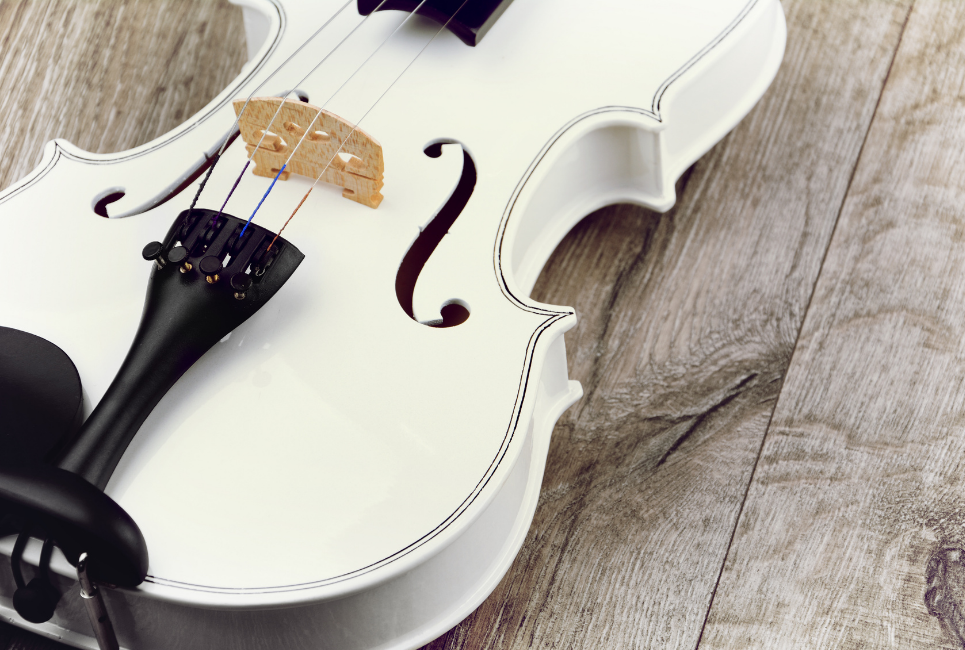- Best Violin Stand Options Guide - May 26, 2022
- Best White Violin Options - May 22, 2022
- How to Find the Best 7/8 Violin - May 19, 2022
When you hear the word ‘violin’, what’s the first thing that you imagine? I would bet you any money that you imagine an instrument that is finely crafted out of spruce or willow, with ebony fittings, and dark brown varnish.
This is certainly what most violins look like, but not all of them – you’ve clearly never seen a white violin!
I’ve been a violinist for the best part of ten years, and I’ve built up a modest collection of seven violins – almost all of which have a standard wooden finish. However, I recently fell in love with a white violin that I saw during a concert performance, and I simply had to buy one.
However, doing so was way more difficult than I initially expected – they’re relatively rare, so I had to search hard.
If you’re looking for the best white violin options and have come across this guide, you’re in luck – I’m here to inform you of all the information that I came across during my search, saving you a ton of research time. Read on to find out more!
Bottom Line Up Front: White violins should never compromise on quality as a result of their unique aesthetic, and the Thomann Europe Electric Violin 4/4 WH is a fantastic example of a white violin that fits this bill.
It is undeniable that there are more electric options for white violins overall due to their more contemporary design, but if you are looking for non-electric alternatives, there are plenty out there too.
Why Choose a White Violin?
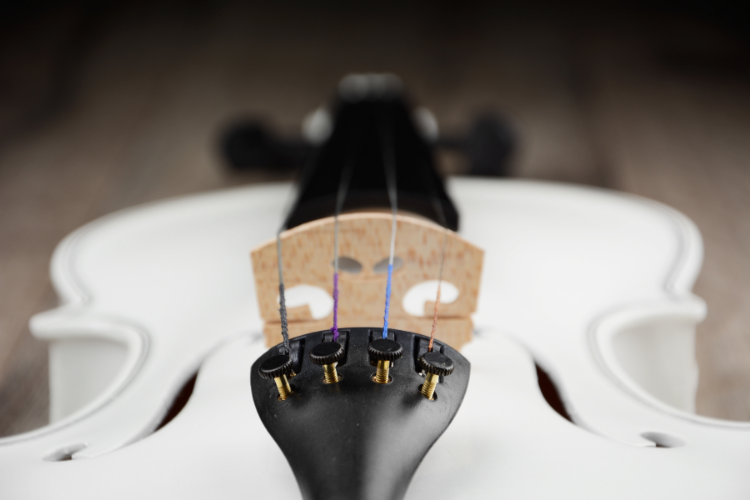
If you’re reading this guide, there’s a high chance that you’ve already made your mind up that you want to purchase a white violin.
However, if you’ve stumbled across it as a violinist and are wondering why on Earth somebody might want to purchase a white violin, I am the dude to ask, as I did exactly that only a couple of years ago.
So, what came over me? Well, there were a few reasons for this, and let me begin by explaining that none of them have anything to do with the sound of the violin or anything like that – it was all to do with the aesthetic.
For starters, I simply think that white violins look cool, it doesn’t have to be more complicated than that! There’s something about the reflective glossy sheen of a white violin that I think looks cool in any setting, whether I am practicing at home or performing on stage.
However, it’s not just about what I think – there is another reason that I ended up purchasing a white violin, and it’s all to do with my orchestra and conductor.
It all began when my conductor announced that we would have an opportunity to perform at a prestigious venue in London, and requested that we all purchase white suits and dresses to look our best uniformly. It was a huge event with a big budget, and this led to people thinking outside the box.
First, the percussionist purchased a white timpani and cymbal stands, and next the cellist purchased a white cello. It wasn’t long until every instrumentalist was performing with a white instrument, and I knew that I had to complete the circle and grab a white violin myself.
Needless to say, we looked awesome, and I will always remember that performance. Our unified look did wonders for our performance, making us connect musically like never before.
Sure, there’s no way that white violins are ever going to replace the traditional wooden finish of violins, there is too much history and culture there, and, arguably, white violins don’t look as cool as wooden ones.
However, I think it’s undeniable that there is a time and a place for a white violin, and I encourage every violin enthusiast to have at least one within their collection!
What to Look for in a White Violin
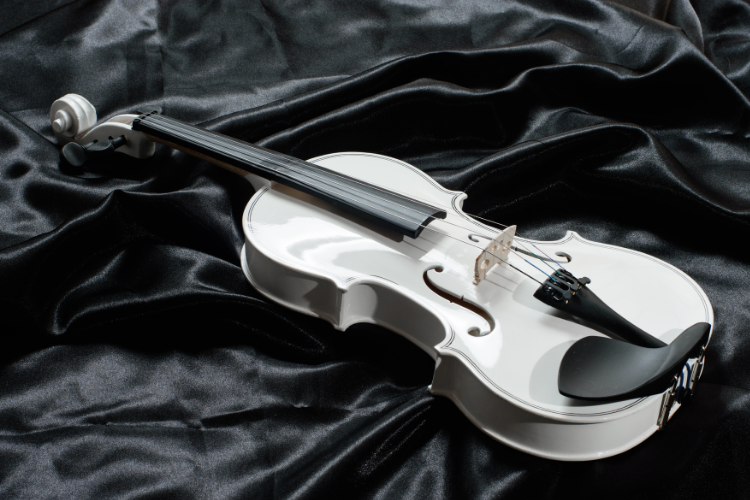
Now that you’ve learned all about why I (and why many others) have decided to purchase a violin, let’s take a look at what exactly you should be looking out for when making a white violin purchase.
Some of these points apply to violins in general, but some are specific to those with white finishes. Let’s get into it.
Smooth White Finish
This first pointer may seem incredibly obvious, but you would be surprised at how many people look past it. When investigating white violins to purchase, you should always ensure that the white finish is smooth and has been applied with great care.
You’d like to think that every violin company producing a white violin would ensure this, but sadly this is not the case.
The fact of the matter is that many violin companies that don’t already produce white violins recognize them as an opportunity to fill a gap in the market. That’s all well and good, but some attempt to fill this gap in the market with a lazy paint job, literally painting a spruce violin with white wall paint.
I shouldn’t have to explain that this is not how the job should be done – it’s going to turn out looking pretty disgusting with the white paint filling the fine grains of the wood.
White finishes should always be applied carefully with special vinyl wraps and paint jobs, and most importantly, the violins should be designed to be white, as opposed to simply being painted white.
It may sound silly, but it’s genuinely something that you should look out for in the reviews section of online listings for white violins. It’s one of the most common complaints that I have come across when doing my research – don’t fall victim to it too!
Zero Compromise on Quality
This next point follows somewhat from the previous discussion of finishes – when violin brands produce white violins, there should be absolutely no compromise on quality.
After all, choosing a white finish is simply an aesthetic preference and has nothing to do with the instrument itself, so why on earth should the quality of an instrument be reduced because of a paint job?
Once again, it may seem baffling that anyone would produce a violin of lesser quality simply because it is painted white, but you would once again be surprised.
Some producers feel that since they have gone to the effort of producing a white violin, they can cheap out on the wood that they use to produce it. No! The wood used to build a violin has hardly anything to do with the look, and is everything to do with the tones that it produces.
It doesn’t have to be made out of rare tonewoods from the Italian mountains, but at least some basic level of wood quality should be assured.
Another classic lazy move is when a white violin doesn’t feature ebony fittings, even though it is very expensive. Sure, if you are on a budget and choose to purchase a cheap white violin, I wouldn’t expect anything too fancy in terms of the fingerboard or tuning pegs.
However, if you spend over $1,000 on a white violin only to discover that the instrument has synthetic fittings, you have been ripped off my friend.
It’s a sad fact of life that some companies out there prey on niche preferences such as this. Another classic example is laziness and reduced quality of left-handed instruments.
Always look out for complaints about this kind of feature in online reviews, because if there’s a compromise, someone is likely to have brought it up already.
Matching White Accessories
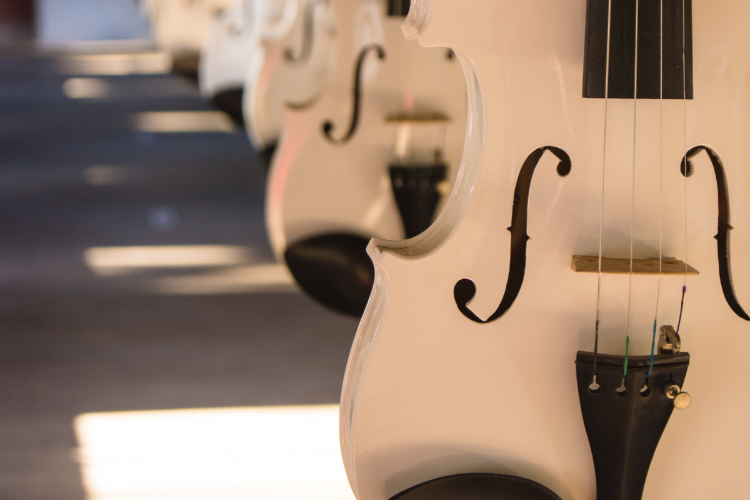
The next purchase point that I want to mention may seem obvious once I mention it, but it is a common mistake that I have seen violinists make – purchasing a white violin that doesn’t come paired with white accessories.
You can’t expect brands to provide you with a white tuner, a white violin stand, and white strings, but you should at least expect the instrument to come with a white bow.
It may sound like I am nitpicking, but you would be surprised at how strange it looks to perform on a white violin with a standardly colored bow. Something just doesn’t look right, and it’s a shame, as it ruins what would otherwise be a unique and classy aesthetic.
Even if a white violin that you like doesn’t come paired with a white bow, you should at least make an effort to investigate whether the brand stocks them. Even if you have to go elsewhere to complete your white look, at least you will look like the bee’s knees!
I’ve come across a ton of white violin accessories on the internet when doing my research, from white hard cases to white strings and white chinrests. Why stop there? Consider grabbing a white tuxedo as I did, and you and your violin will look incredibly cool during performances!
A Size That Fits
The last point that I believe everybody should look out for when purchasing a white violin is sizing.
This should go without saying really – instruments come in a huge variety of shapes and sizes, and purchasing one that doesn’t fit correctly could make for a highly uncomfortable performance experience, or even worst, prevent you from learning the instrument in the first place!
However, I think that it’s particularly important when it comes to white violins, purely because white violins are difficult to find, and therefore when someone finds one online, it can be tempting to pull the trigger immediately.
They’ve been searching so hard for the perfect white violin that they got tunnel vision, completely forgetting to check basics such as sizing.
If you’ve been a violinist for many years, it’s unlikely you’re going to make a mistake like this, as you will already be familiar with the size that fits you and the complications that would arise if you got this wrong.
However, if you are a beginner violinist, please do not jump to the assumption that you should just purchase a full-sized white violin. It may be the only one that you can find, but if it ends up being too big for you, then the whole purchase will have been pointless.
My best piece of advice would be to head to your local orchestral music store if you are stuck with sizing and ask a member of staff to give you a hand. For the time being, you can test out violins of any color or finish, as this doesn’t affect
the size of the instrument. Once you have found a violin size that is comfortable to hold and that you can navigate with ease, it’s time to start checking out white alternatives online!
My Top Three White Violin Recommendations
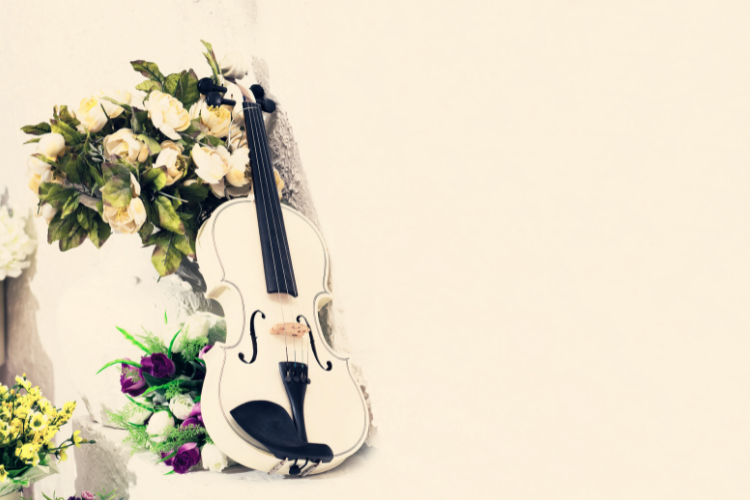
Sheesh, who knew purchasing a white violin could be so complicated? It’s only a color, yet it truly does add a lot of complications to the purchasing process.
However, you should now be aware of the potential challenges that you may face, so let’s move forward and take a look at my three top white violin recommendations. I hope there’s one on the list that you like – the criteria that I used to decide on each violin is as follows:
- Gorgeous white finish
- Absolutely no compromise on the build and wood quality, despite being white
- Comfortable to play
- Excellent reviews
- Built from quality tonewoods
- Good value for money
Hobgoblin VW-3 Violin in the White 4/4
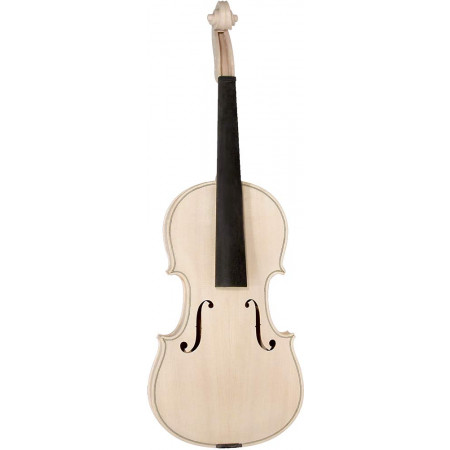
The first white violin that I would like to recommend is undeniably an unusual product recommendation for one major reason – the Hobgoblin VW-3 Violin In The White 4/4 does not come with strings, a tailpiece, tuning pegs, or other fittings (other than the fingerboard of course).
It is sold exclusively as a gorgeous white violin body, ideal for anyone looking to build their own violin piece by piece.
If you’re looking to buy a white violin outright then this product isn’t going to be for you, but if you’re happy to get your hands dirty, it’s great value for money. It features a hardwood fingerboard, nut and sadly, solid maple back and sides, and a Grade A hand-carved spruce top.
The finish looks stunning and I can only imagine that it would look even better once it is kitted out with matching fittings.
Pros
- Gorgeous white finish
- Handcarved Grade A spruce top
- Solid maple back and sides
Cons
- Only sold as the body, without strings, a tailpiece, or fittings
- Only available in 4/4, making it unsuitable for children or smaller adults
- Fingerboard is made out of hardwood as opposed to ebony
Thomann Europe Electric Violin 4/4 WH
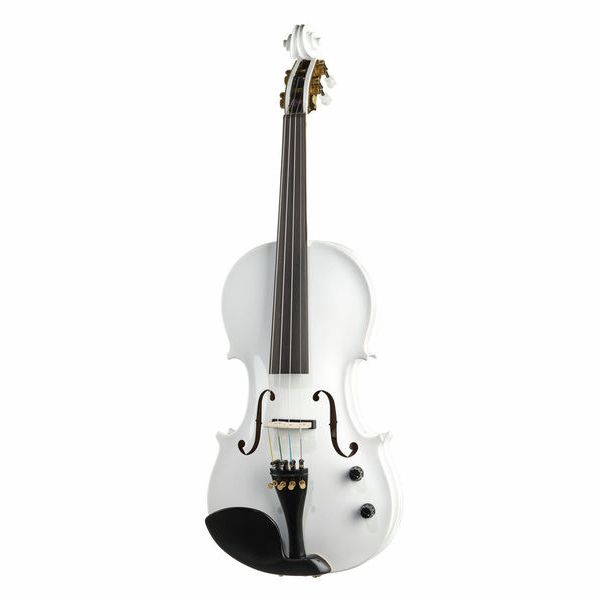
The next recommendation on my list of the best white violins is produced by one of my favorite beginner brands, Thomann.
Unlike the last recommendation, some will be happy to know that this violin comes as a complete package, including tuning pegs, a tailpiece, and strings, in addition to a 3-Year Thomann Warranty.
It’s a slight upgrade on the previously mentioned Hobgoblin body, being built with an Ebony fingerboard and a solid spruce top, back, and sides. However, the true stand-out feature here is the fact that this violin is electric!
This means that you can amplify this violin at any volume for any sized venue, whilst also adjusting the tone controls to get it sounding exactly how you like it.
I’m a big fan of this electric white violin since it is wooden, not carbon fibre. It seems that every time I find a white violin that I like, it’s carbon fibre, and whilst there is nothing inherently wrong with that, it’s just not for me – I prefer the rich tones of spruce.
Pros
- An electric violin, facilitating amplification at any volume
- Made out of spruce and ebony as opposed to carbon fibre, despite being electric
- The white body is matched beautifully by the black tailpiece, nut, and tone controls
- Comes with a 3-year Thomann warranty
Cons
- Many people who are in the market for an electric violin specifically want one made out of carbon fibre, not wood
- Doesn’t come with a matching white bow
- Only available in 4/4
Gewa Novita 3.0 Electric Violin
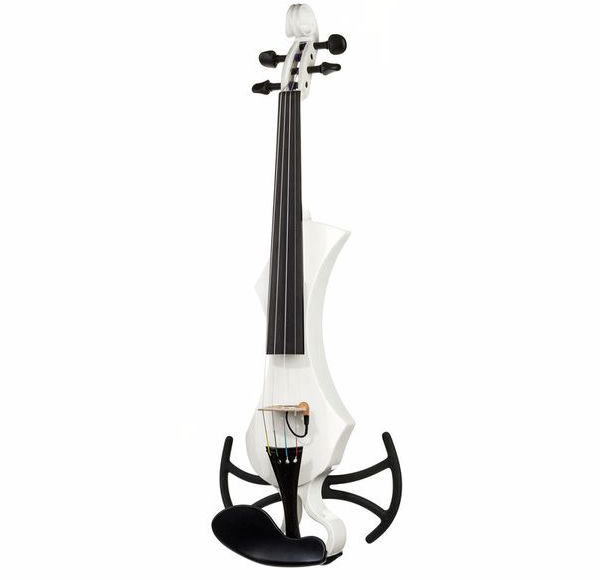
The last violin that I wanted to recommend is something that I believe you won’t have come across before – it’s the Gewa Novita 3.0 Electric Violin.
That’s right, I’m recommending another electric violin because there seems to be quite an abundance of white violins that are electric, so it’s a fair representation.
The first thing that will surprise you about this violin is its aesthetic – it looks completely different from a traditional violin, and that’s not got anything to do with its white paint job.
The wooden body is extremely thin, carved in an hourglass shape to provide a contemporary appearance that will blow the mind of its audiences.
It’s another great example of how electric violins don’t have to be made out of carbon fiber, with this example having the top crafted out of spruce, the back out of maple, the bridge out of Aubert, and the fingerboard out of ebony!
It also includes an ebony top nut, a Wittner tailpiece, chinrest and tuning pegs, and a white finish that is easily the best featured on this list.
The only problem with this electric white violin is the price and the aesthetic – I’m personally a huge fan of how it looks, but I’ve shown a few of my friends and this has made me realize that it is not for everyone.
It is also by far the most expensive violin on this list, adding to the overall atmosphere that this is an intermediate to professional violin, not for beginners.
Pros
- Unique contemporary hourglass design
- The slim design makes it ultra-lightweight and comfortable
- Ebony fingerboard and top nut
- Electric, facilitating any volume or tone
- Overall high-quality build
Cons
- The bizarre design is seen as ugly by many people
- A pretty expensive option, despite the high-quality
FAQs
I hope that you have learned a lot from this guide to the best white violin options. I tried my best to provide a variety of different product types, whilst providing you with everything I wish I knew back when I was purchasing my white violin.
To finish things off, I’ve decided it will be beneficial to close with a quick FAQ – that way, if you have any last-minute burning questions, we can cover them before we depart!
Answer: A common red flag when buying a white violin is if the reviews state that the white finish is patchy or has been lazily painted on.
Answer: The only difference between a white and regular violin should be the color, and as long as the brand is decent, there should be no compromise on quality.
Answer: The best way to find a white violin that fits you is to head to a music store and ask a sales assistant to help you work out what size you are.
Answer: Absolutely – Thomann is one of the most famous beginner brands for white violins, and as long as you are not looking for extremely high quality, you should be satisfied with their service.
Final Thoughts
That brings us to the end of this guide to the best white violin options! I hope that you now have a better idea of what to look for when purchasing a white violin, what to avoid, and why white violins should never have any form of quality compromise – period.
If I were to go back to when I was purchasing my first white violin after learning everything that I have, I would likely choose the Hobgoblin VW-3 Violin In The White and build upon it, as I love DIY jobs and it would be a great advanced project.
However, if you’re a beginner, there’s no denying that the Thomann Europe Electric Violin 4/4 WH is going to be more appropriate, assuming you don’t mind having an electric violin that is!
Good luck on your journey, and remember – if anyone ever tells you that white violins are not as good as regular ones, you should show them this article and prove to them otherwise!
Looking for more interesting readings? Check out:

